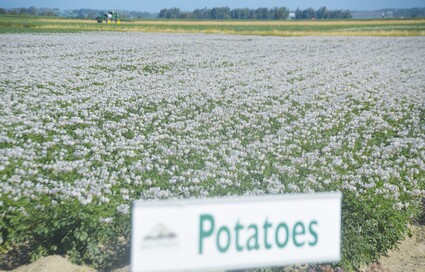Fine weather for many crops, as long as farmers irrigate
August 2, 2023

Ken Stern
LET A THOUSAND POTATO FIELDS BLOOM – If it is July in Skagit County, potato fields are blooming pink or white as here, just north and west of the La Conner roundabout. These potatoes, grown by Maplewood Farm, are a few of the thousands of acres planted in the Valley this year.
Skagit County is officially in a drought emergency – but so far, some area farmers are having a pretty good year.
Swanson Family Farm's berry crop was bountiful. "We went from a 10 percent crop and lots of freeze damage last year to a 110% crop this year," said Dean Swanson. He is already picking corn and thinks his cucumber and bean crops will be good.
Potatoes "look good," said John Thulen of Pioneer Potatoes, "not lackluster, but not a crasher either, although some plants look stressed."
Planting conditions were "pretty close to ideal," said Jason Vander Kooy of Harmony Dairy, with some spring showers but none of the record-setting June 2022 rains that flooded fields and delayed planting.
This year, crops went in right on time or early. "We had heat in May, everything is warm, all you have to do is add water," said Ray deVries of Ralph's Greenhouse. "But it's dry. If you can't irrigate your ground, you got a problem."

With rainfall 7 inches below normal, water guns and drip irrigation systems have been running since June.
"We have also been irrigating a lot more heavily," said Vander Kooy. The six-tenths of an inch of rain that fell Monday, July 24, was helpful. "Corn can capture rain and funnel it right to the roots. That's what keeps corn alive in dry areas."
Where there is water, corn is tall, pasture grass is green and potato plants are big enough to achieve row closure by casting enough shade to preserve soil moisture. Where there is little water, corn is short and pastures look stressed. Spreading manure on pasture grass can keep it green and alive until the rains return. Vander Kooy is only manuring his newer pastures. "A couple older grass fields I have to walk away from."

Growers use big water guns to irrigate corn, pasture grass and potatoes. Farmers of specialty vegetables like Swanson and deVries use drip irrigation.
"I'm not spraying water into the sky," said Swanson. "It's going where it needs to go. I want beans that are straight, I don't want cucumbers that are stressed and crooked."
Swanson is on "city water" from the Skagit Public Utility District. It is reliable, but expensive. To economize, flower grower Beth Hailey of Dona Flora, also on city water, has been prioritizing her transplants. "It's a struggle to figure out what to water next – basically babies and things that look like they will fall down," she said. Many varieties are shorter than usual, so she is making lots of miniature bouquets.
Before installing equipment that let him switch to the PUD's agricultural rate, city water was costing Chris Dariotis of La Conner Gardens $1,000 a month. Fortunately, garlic, his major crop, doesn't need to be irrigated during summer. The one July rain "loosened up the soil so we could bring in the last of the garlic," he said. "Even the crops we irrigate seemed to enjoy getting some rain."
Thulen, Vander Kooy and other bigger farmers use Skagit River water for irrigation – but not when the Skagit River's instream flow drops below 10,000 cubic feet per second, the Washington State Department of Ecology's baseline for keeping fisheries healthy.
When the river dropped in early July, irrigation pumps that fill ditches were shut off. Fortunately, on July 25, the PUD agreed to transfer some of its unused water rights to Skagit County Drainage and Irrigation Improvement District 15, which supplies the flats east of Best Road, and District 22, which supplies water closer to La Conner. The pumps turned on again.
"This is a wonderful agreement, and I appreciate that Skagit PUD was part of the solution," said Thulen, a District 22 commissioner. "Now we need to get something permanent in place so we can start using water earlier, before there is an emergency. Not a lot of irrigating happens in August, but July is an important month."
During the two weeks the water was off, seed spinach in at least one field bolted and was plowed under to cut losses. "In my dad's youth, you never irrigated spinach. Now everybody is irrigating their seed crops. It's not going to be a good year for spinach," said Thulen.

Farming is different every year – but as the climate changes and drought and water shortages become more common, the varieties of crops grown in the valley may change.
"Broccoli used to be big in the valley, but it used a lot of water, so you only see small patches now," said Thulen. "We are trying out types of potatoes that we can grow with less water. Across the U.S., farmers are asking, how can we adapt?"



Reader Comments(0)